Index
Introduction
The Monkey Face Orchid, scientifically known as the Dracula Simia, captivates orchid lovers with its unique and intriguing appearance. Originally from the humid forests of Central and South America, this orchid displays extraordinary flowers that resemble the face of a monkey. Its name “Dracula” refers to the two long pendulous spurs, adding a touch of mystery to this botanical gem.
Meaning of the Monkey Face Orchid
In addition to its aesthetic appeal, the Monkey Face Orchid carries symbolic meanings. Associated with individuality and adaptability, this unique orchid reminds us of the diversity in nature and the importance of embracing our uniqueness. Growing this floral jewel not only adds beauty to the environment, but also provides a special connection with the exuberance of tropical flora.
| Common Name | Monkey Face Orchid |
|---|---|
| Botanical Name | Dracula simia |
| Family | Orchidaceae |
| Plant Type | Epiphytic orchid |
| Adult size | Small to medium, varies between 20 and 40 cm |
| Sun exposure | Filtered light to shade |
| Soil type | Specific substrate for epiphytic orchids |
| soil pH | Slightly acidic to neutral |
| Flowering time | Spring to summer |
| Flower color | Various shades, often orange and brown |
| Native Area | Central and South America, in humid and shady environments |
| Toxicity | Not reported, but standard care when handling orchids should be observed |
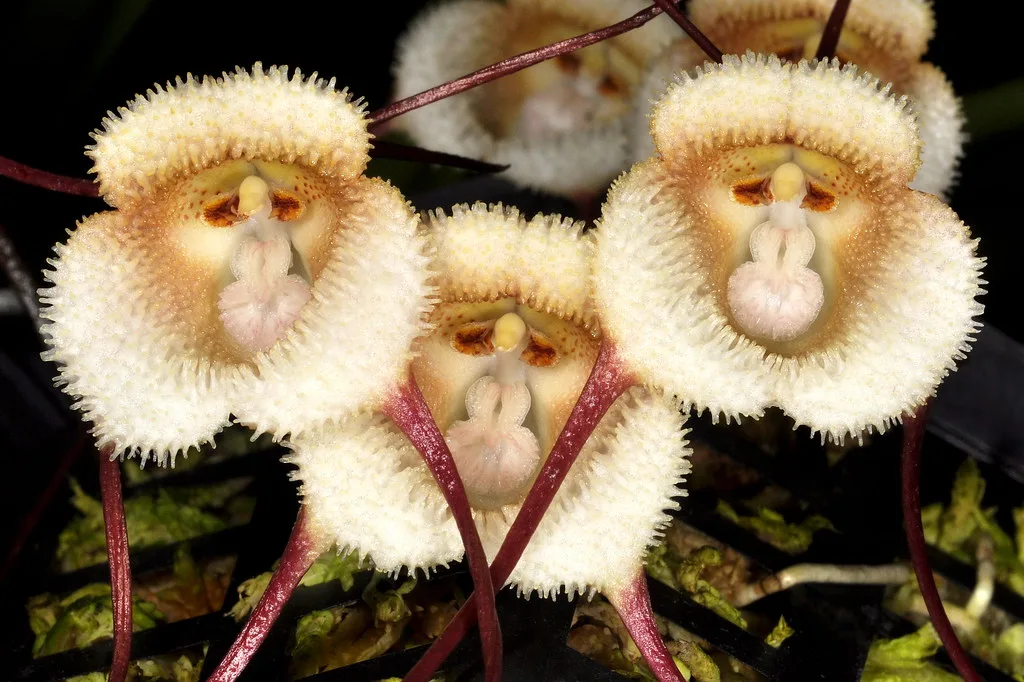
How to Care for the Monkey face Orchid
The Monkey Face Orchid requires specific care to flourish to its full potential. Below, we detail the essential aspects to consider to ensure the well-being of this charming orchid.
Light:
The Monkey Face Orchid prefers filtered light to shade. Avoid direct exposure to the sun, opting instead for rooms with diffused light. Places with light curtains or well-lit indoors are ideal for growing them.
Soil:
Use a suitable substrate for epiphytic orchids. These orchids naturally grow on surfaces such as tree trunks. A well-drained substrate that simulates these conditions is crucial for successful cultivation.
Water:
Water sparingly, keeping the substrate slightly damp. Avoid excessive accumulation of water in the pot, as the orchid’s root system is sensitive to excess moisture.
Temperature and humidity:
Maintain mild temperatures and a humid environment. The Monkey face Orchid thrives in tropical conditions, with temperatures between 18°C and 24°C. Maintaining a higher level of relative humidity contributes to its healthy development.
Fertilizing:
Fertilize the orchid regularly during the active growing season. Choose a balanced orchid fertilizer and follow the recommended dilution instructions. Fertilizing helps provide the nutrients needed for vibrant blooms.
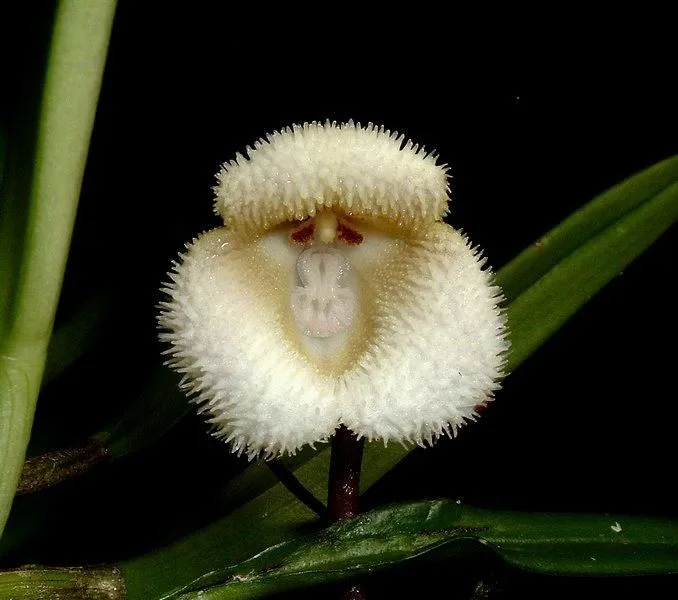
How to make Monkey Face Orchid Cuttings
1.Choose a healthy plant: Opt for an adult, vigorous orchid to ensure successful propagation.
2. Carefully remove from the pot: Remove the orchid from the pot, preserving its roots.
3. Identify healthy shoots: Locate lateral shoots or pseudobulbs that can be separated.
How to plant the Monkey Face Orchid Seedling
1. Preparing the substrate: Use a specific substrate for epiphytic orchids, ensuring good aeration and drainage.
2. Separating the seedling: Cut the seedling, ensuring that each part has healthy roots.
3. Planting in the new base: Plant each seedling in a new pot, lightly pressing the substrate around the roots.
4. Initial watering: Carry out a gentle watering to fix the substrate around the roots.
By following these steps, you will be providing an environment conducive to the healthy development of your Monkey Face Orchid seedlings.
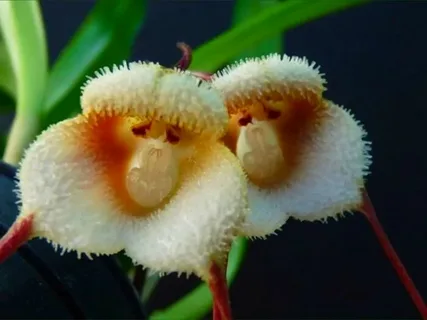
Pests and diseases
Common pests:
- Mites: Identifiable by fine webs on the leaves. Use specific insecticides for mites.
- Mealybugs: Small insects that feed on the sap. Remove by hand or use mineral oil.
Diseases:
- Root rot: Results from excess humidity. Adjust watering and replant in a more draining substrate.
- Mildew: White spots on the leaves. Treat with appropriate fungicides.
Common Problems and Their Solutions:
Yellowing leaves:
Cause: Overwatering or lack of nutrients. Solution: Adjust watering and provide balanced fertilizer.
Withered leaves:
Cause: Lack of water or prolonged exposure to the sun. Solution: Water properly and adjust sun exposure.
No flowers:
Cause: Lack of light or plant stress. Solution: Move to a brighter location and provide a less stressful environment.
By quickly identifying potential problems and acting with appropriate solutions, you will keep your Monkey face Orchid healthy and lush.
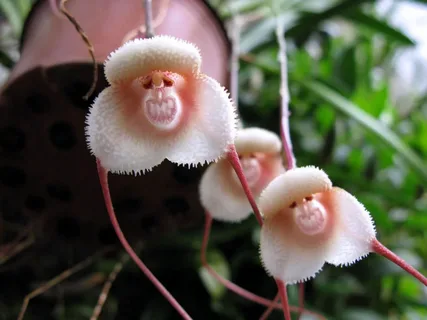
Curiosities and myths
Curiosities:
- Exotic origin: The Ape Dracula is native to the humid forests of Central and South America, where it grows naturally on tree trunks.
- Strategic Flowers: Its flowers have a peculiar appearance, resembling monkeys’ faces, which contributes to its common name “Monkey Face”.
- Specialized Pollination: The pollination of Dracula simia often involves attraction through odours that mimic substances found in animal faeces.
Myths:
- Demanding Orchid: Although it has its preferences, the Ape Dracula can be successfully cultivated by orchid enthusiasts and is not as demanding as some myths suggest.
- Extreme Rarity: Despite its unique characteristics, the Monkey Face Orchid is not as rare as some myths suggest, and it is possible to find it in orchid growers’ collections.
Exploring these curiosities and dispelling myths contributes to a deeper and more informed appreciation of the fascinating Monkey face Orchid.
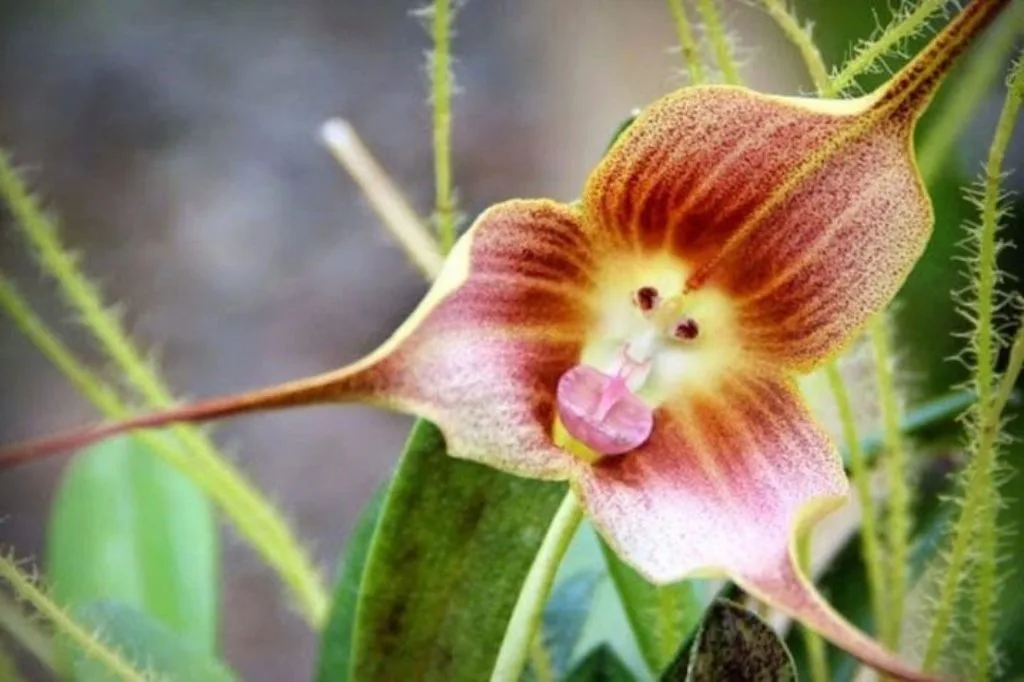
Conclusion
As we explore the nuances of the Monkey Face Orchid(Dracula simia), we delve into a universe of peculiarities and fascination. Its flowers, which resemble monkey faces, enchant with their originality, while their curiosities reveal intriguing adaptations for their survival in specific environments.
We debunk the idea that this orchid is too demanding, discovering that, with the right care, it can thrive in enthusiasts’ collections. By understanding the myths surrounding this plant, we pave the way for a more accessible and sustained appreciation. Growing the Monkey Face Orchid is thus not only an aesthetic experience, but also an invitation to unravel the mysteries of nature and appreciate the unique diversity of orchids.
Frequently Asked Questions
Which orchids are rare?
There are several orchids that are considered rare due to their limited geographical distribution, peculiarities in their flowers or difficulty in cultivation. Examples include Paphiopedilum rothschildianum and Grammatophyllum speciosum.
What is the most expensive orchid in the world?
The most expensive orchid in the world is the “Shenzhen Nongke Orchid”. In 2005, it was auctioned for around 1.68 million dollars. Its rarity, beauty and the extraordinary length of time it took to cultivate contributed to its exceptional value.
Is there a flower with a monkey face?
Yes, there are flowers with features that resemble monkey faces. A notable example is the Monkey Face Orchid (Dracula simia), whose flowers have a distinctive appearance reminiscent of a monkey’s face, delighting admirers of nature.







